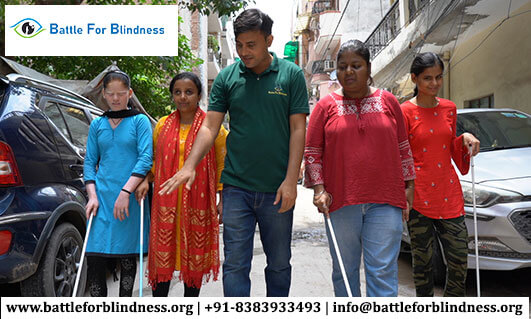
Good sleep hygiene is essential for everyone, but it’s especially important for individuals who are blind or visually impaired. Proper sleep helps maintain physical health, mental clarity, and emotional well-being. However, people with visual impairments may face unique challenges that can affect the quality of their sleep, such as difficulty with light perception, sleep patterns, and managing their environment for optimal rest. In this blog, we will explore effective sleep hygiene practices tailored for blind individuals to help them achieve better sleep and improve overall health.
1. Establish a Consistent Sleep Schedule
One of the most crucial sleep hygiene practices is maintaining a consistent sleep schedule. For individuals who are blind, the body’s internal clock, or circadian rhythm, may be affected by the absence of natural light cues. Establishing a fixed bedtime and wake-up time each day can help regulate the sleep cycle.
- Set Alarms: Use a tactile or voice-activated alarm to set regular wake-up times and bedtime reminders. Consistency in timing helps train the body to fall asleep and wake up at the same time each day, even without visual cues like sunlight.
- Wind Down Rituals: Developing a routine before bed, such as listening to calming music, reading (using braille or audiobooks), or practicing relaxation techniques, signals the body that it’s time to wind down.
2. Optimize Your Sleep Environment
Creating a comfortable and calming sleep environment is essential for quality rest. While visually impaired individuals may not rely on darkness to sleep, other factors can contribute to a more restful sleep.
- Sound Management: Sound is a significant factor for many blind individuals. A quiet environment promotes better sleep. Consider using white noise machines, soft music, or a fan to mask any disruptive sounds in the environment.
- Temperature Control: Keep the room cool but comfortable. The optimal sleeping temperature is around 65-70°F (18-21°C). Using tactile indicators on the thermostat or a smart home system can help monitor the temperature.
- Bedding: Choose comfortable bedding and pillows that suit your preferences, and ensure that the sheets and blankets are soft and not restrictive.
3. Limit Stimulants and Distractions
In the hours leading up to bedtime, it’s essential to avoid activities or substances that may interfere with sleep. Stimulants like caffeine and certain foods can disrupt the body’s ability to relax and fall asleep.
- Caffeine-Free Evening: Avoid caffeinated beverages, such as coffee, tea, and sodas, at least 6 hours before bedtime. The stimulating effects of caffeine can stay in the body for several hours, making it harder to fall asleep.
- Light Exposure: For those who use electronic devices before bed, the light from screens may affect sleep quality. However, since blind individuals may not use visual screens in the same way, it’s still important to consider other sensory stimulation, such as reducing overly stimulating activities like intense discussions or work-related tasks.
4. Use Technology to Your Advantage
Modern technology can be incredibly helpful for enhancing sleep hygiene for individuals with visual impairments. Several devices and apps are available that can assist in monitoring sleep, creating calming environments, and managing sleep routines.
- Sleep Trackers: Wearable devices, like a fitness tracker with a sleep-monitoring feature, can help track sleep patterns, even if you are blind. Some devices offer vibrations or sounds to wake you up at the right time in your sleep cycle, ensuring you wake up feeling refreshed.
- Smart Home Devices: Voice-controlled assistants, such as Amazon Alexa or Google Assistant, can help with controlling lighting, setting alarms, and managing other aspects of the environment without needing to rely on visual cues.
- Relaxation Apps: Many apps provide guided meditation, breathing exercises, or relaxing sounds designed to promote sleep. Apps like Calm, Headspace, or even YouTube offer audio guides to help with falling asleep.
5. Incorporate Relaxation Techniques
Relaxation techniques are crucial for calming the mind and body before sleep. Incorporating these practices can help reduce stress, anxiety, and physical tension, all of which contribute to better sleep.
- Deep Breathing: Practice deep breathing exercises, such as inhaling deeply for 4 seconds, holding for 4 seconds, and exhaling for 4 seconds. This technique reduces stress and prepares the body for sleep.
- Progressive Muscle Relaxation: This involves tensing and relaxing different muscle groups in the body to relieve tension. Starting from the feet and working your way up to your head can help promote overall relaxation.
- Aromatherapy: Certain scents, like lavender, are known to have a calming effect. Using a diffuser or placing a scented pillow near the bed can help signal to the body that it’s time to wind down.
6. Exercise During the Day
Regular physical activity has been shown to improve sleep quality by reducing stress, promoting relaxation, and helping regulate circadian rhythms. However, it’s important to time your exercise properly to avoid any disruptions to your sleep.
- Avoid Evening Workouts: While exercise can improve sleep, engaging in vigorous physical activity too close to bedtime can have the opposite effect. Aim to finish intense exercise at least 3 hours before you go to sleep.
- Low-Impact Activities: If evening exercise is necessary, consider light stretching, yoga, or walking. These activities help the body relax without overstimulating it.
7. Seek Professional Help if Needed
Sometimes, despite our best efforts, sleep problems persist. If you continue to experience trouble sleeping despite following healthy sleep habits, it may be helpful to seek professional advice.
- Consult a Sleep Specialist: A sleep specialist can help identify underlying sleep disorders such as insomnia or sleep apnea, which may require medical intervention or treatment.
- Therapy and Counseling: For those who experience anxiety, depression, or stress that interfere with sleep, therapy or counseling may be beneficial. Cognitive behavioral therapy (CBT) has been shown to help people with sleep issues, including those with visual impairments.
Conclusion
Sleep hygiene is a vital part of maintaining overall health and well-being, especially for blind individuals. By establishing a consistent sleep schedule, optimizing the sleep environment, avoiding stimulants, and using technology to enhance sleep routines, visually impaired individuals can improve their sleep quality and, in turn, their health. Relaxation techniques, daily exercise, and seeking professional help when necessary can further support better sleep. By taking these steps, blind individuals can foster healthy sleep habits that improve their quality of life, enhance mental clarity, and promote a greater sense of well-being.





